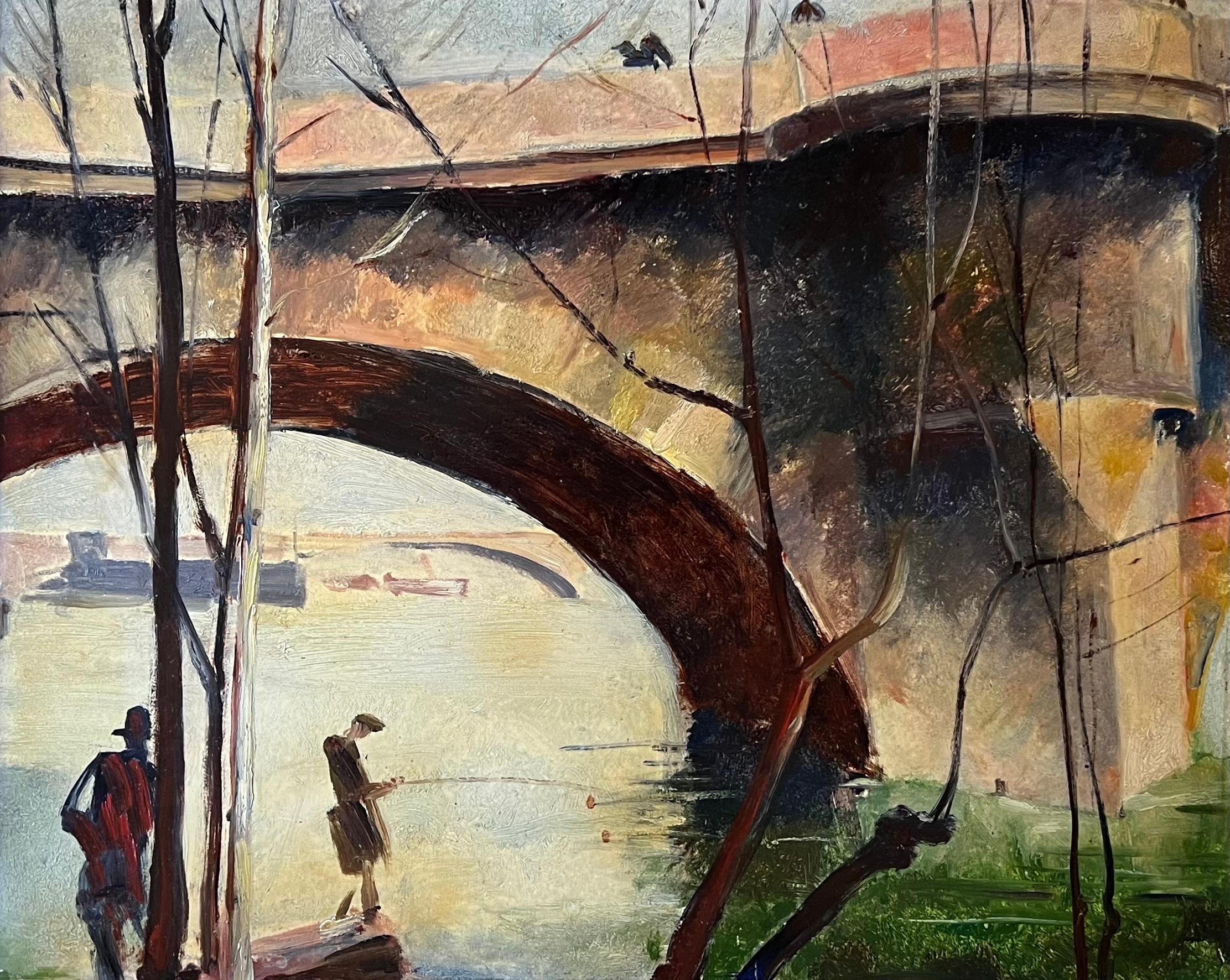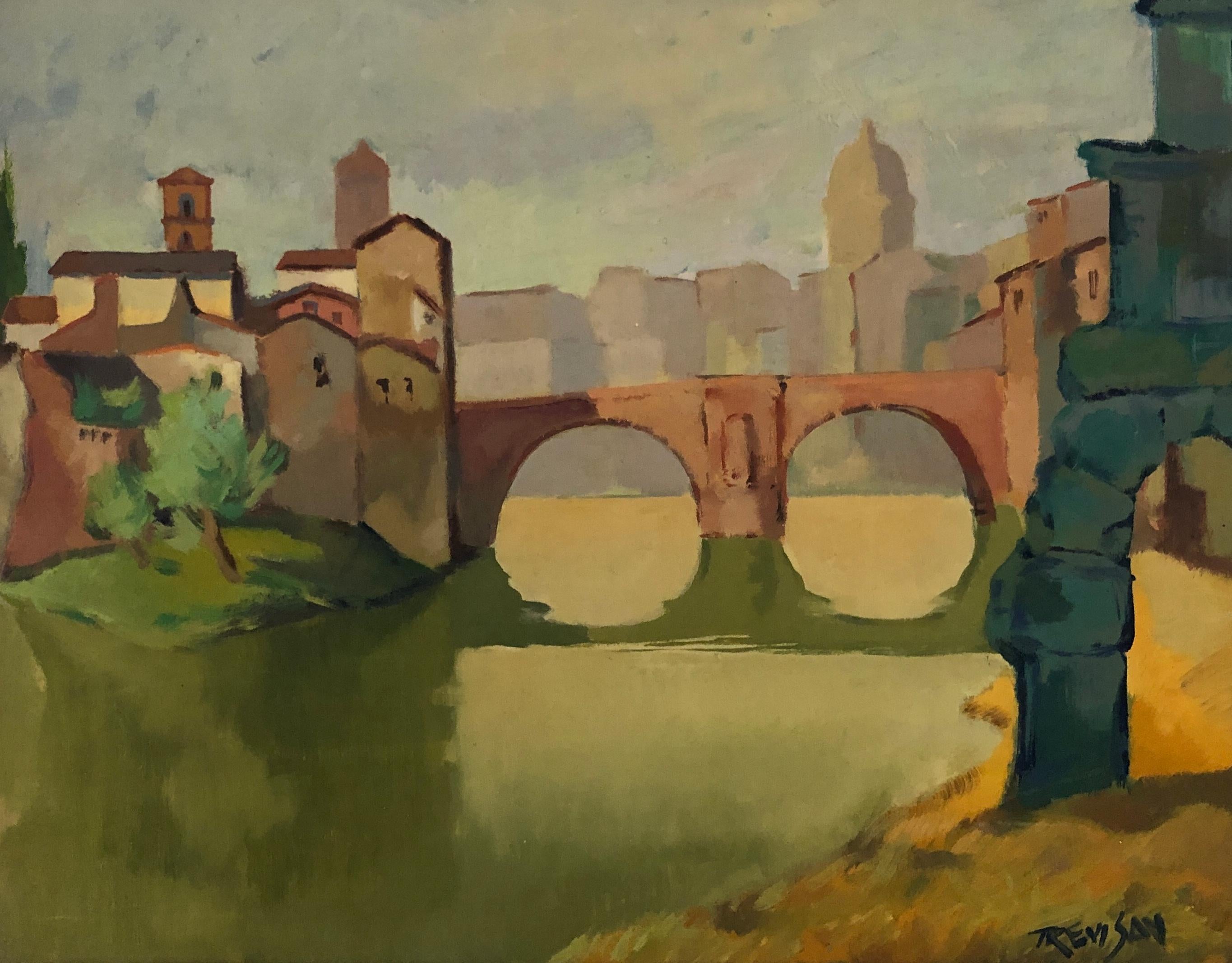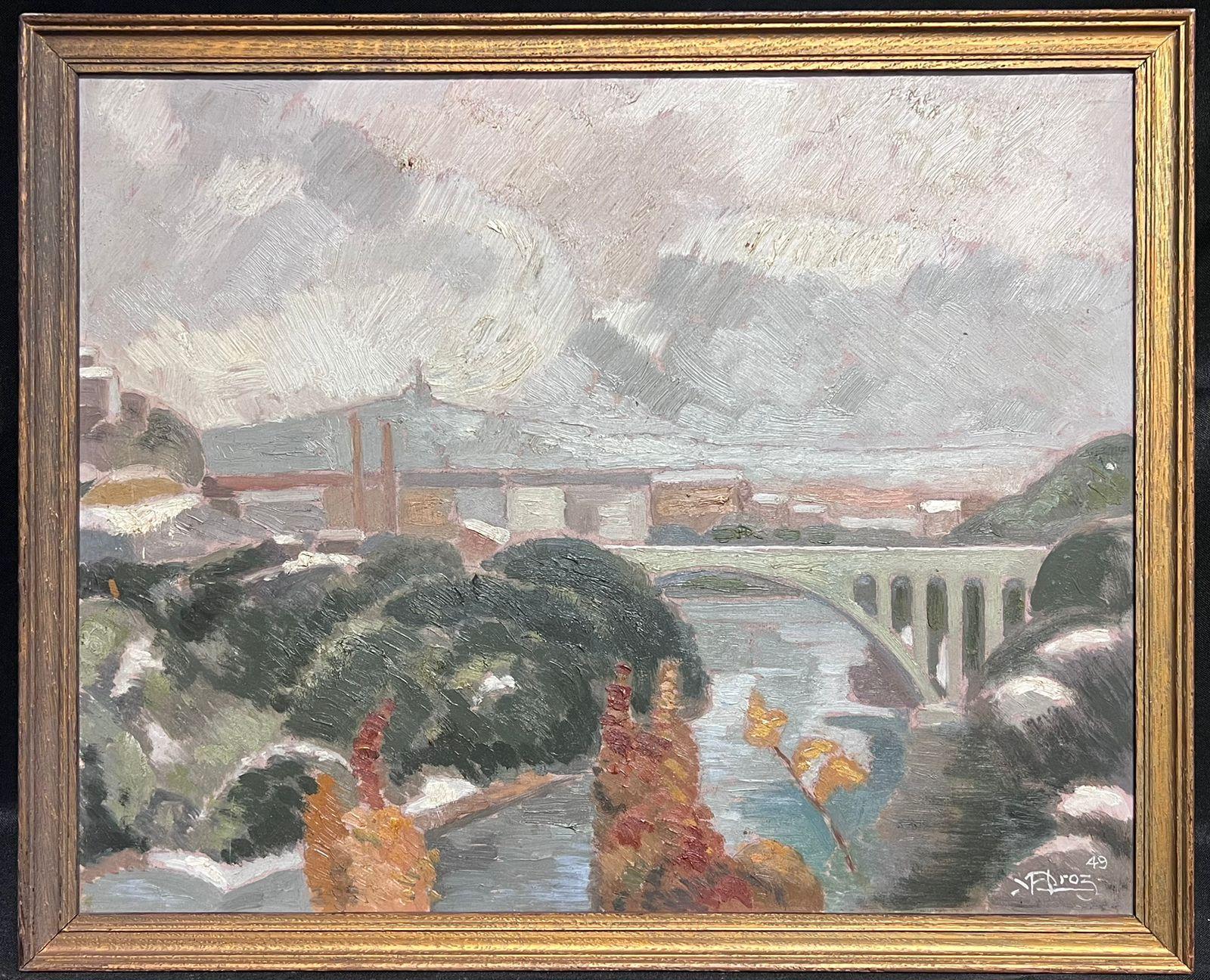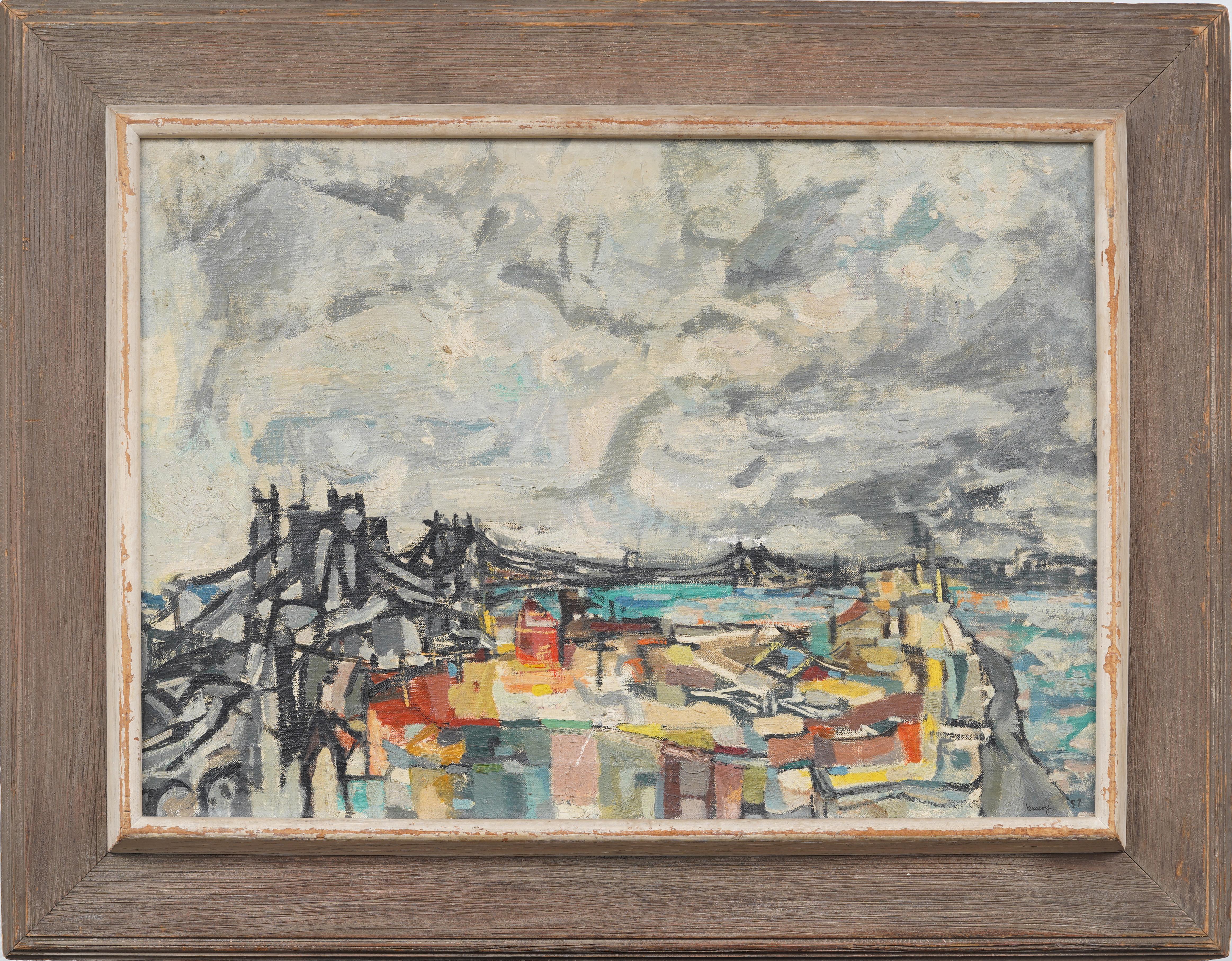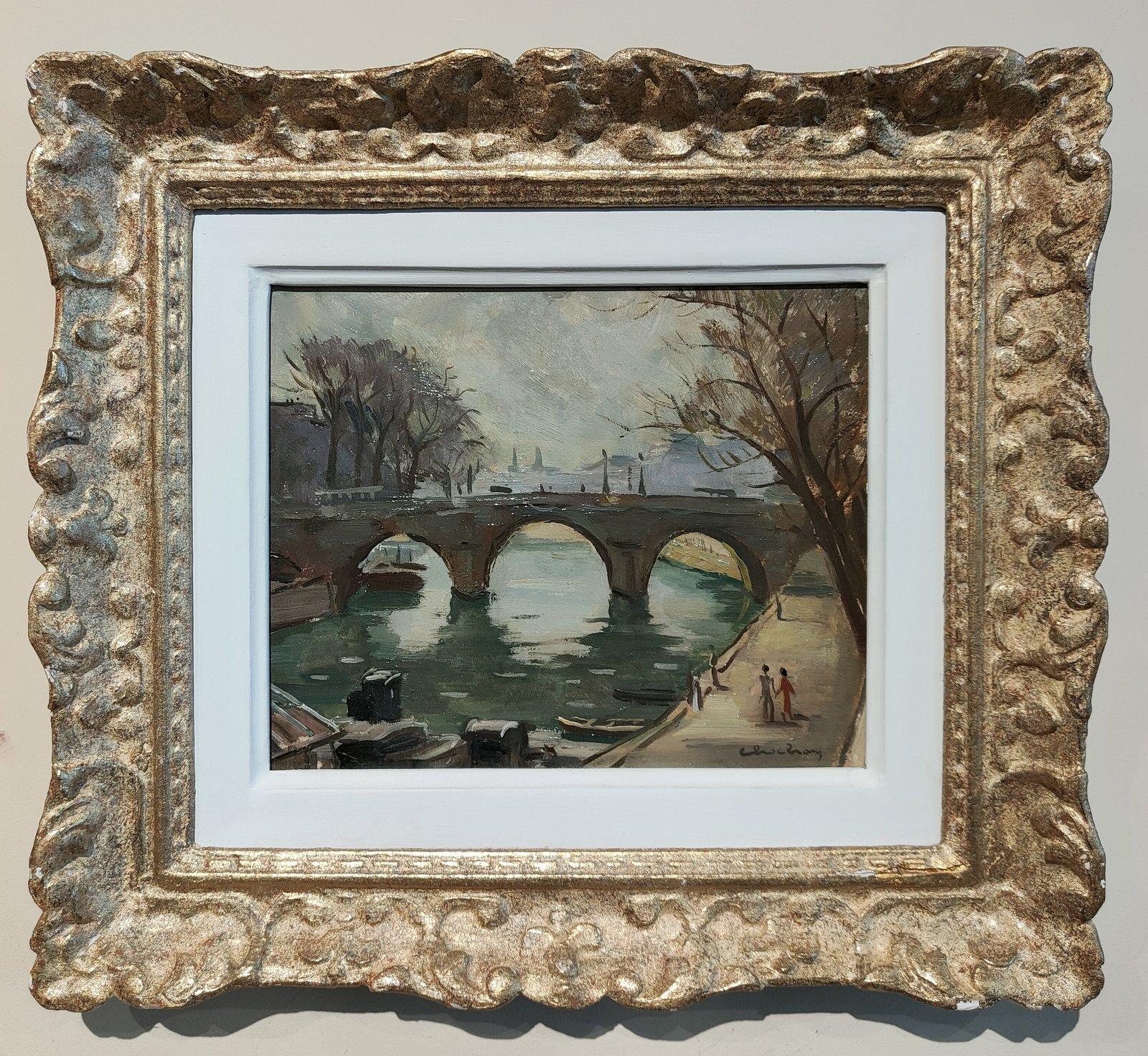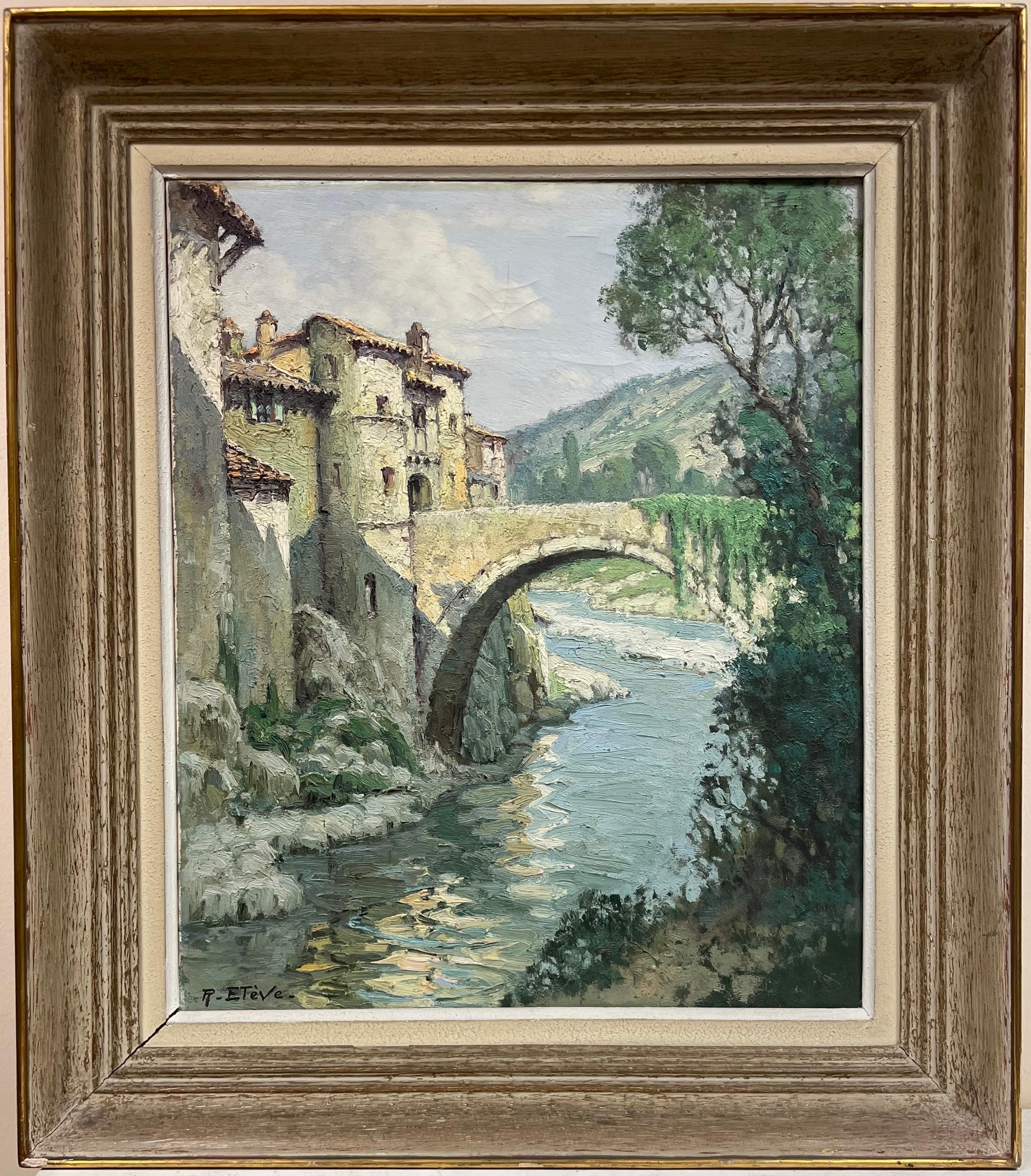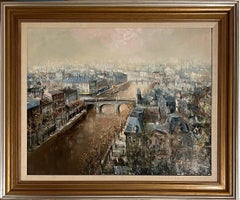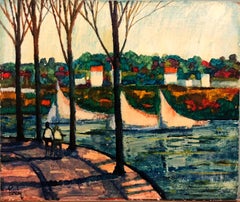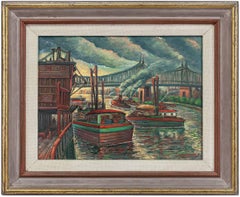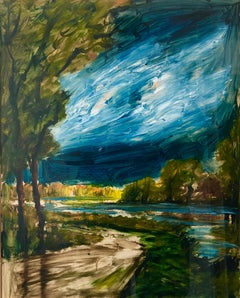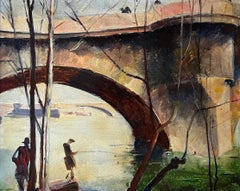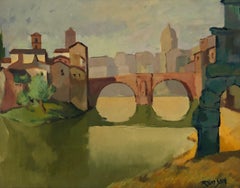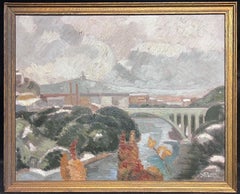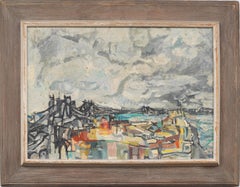Items Similar to Large Modernist Oil Painting Bridge over the Water Landscape
Want more images or videos?
Request additional images or videos from the seller
1 of 8
Saul ScharyLarge Modernist Oil Painting Bridge over the Water Landscape
$3,800
£2,859.15
€3,302.38
CA$5,370.39
A$5,827.69
CHF 3,088.16
MX$71,473.83
NOK 38,215.81
SEK 36,111.92
DKK 24,653.88
About the Item
Saul Schary was born in 1904 in Newark, New Jersey. Painter, Printmaker, Illustrator. He lived and worked in New York City and New Milford, Connecticut. Schary studied at the Art Students League, New York; the Pennsylvania Academy of Fine Arts, and abroad in Paris.
He was a member of the Artists Equity Association, New York City; the Pennsylvania Academy of Fine Arts (Fellow); the College Art Association of America, New York City; and the Royal Society of Artists, London.
His work has been exhibited at several museums including the Whitney Museum of American Art NY. Schary has also exhibited with the Pennsylvania Academy of Fine Arts Annual (1933-51), Art Institute of Chicago, California Palace of the Legion of Honor and Allied Artists of American Gallery (Los Angeles, CA). This fine example is signed Schary. Well Listed: Askart, Who Was Who In American Art, Davenport's Art Reference and Price Guide, Mallett. lifelong friend of Arshile Gorky.
Schary partook in the First American Artists' Congress Against War and Fascism in 1935, which produced a petition signed by more than 300 artists including co-founders Stuart Davis, Adolph Dehn, William Gropper, Hugo Gellert, Saul Schary, and Moses Soyer as well as many fellow artists. (Milton Avery, Ben Shahn, Raphael Soyer, Max Weber, amongst others)
Perls Galleries
Associated American Artists Galleries
Harry Salpeter Gallery
St. Louis Art Museum Richardson Memorial Library
Gallery of Mrs. Cornelius J. Sullivan
Joseph Luyber Galleries
- Creator:Saul Schary (1904 - 1978, American)
- Dimensions:Height: 23 in (58.42 cm)Width: 31 in (78.74 cm)
- Medium:
- Movement & Style:
- Period:
- Condition:minor wear, minor wear to frame.
- Gallery Location:Surfside, FL
- Reference Number:1stDibs: LU38212562232
About the Seller
4.9
Platinum Seller
Premium sellers with a 4.7+ rating and 24-hour response times
Established in 1995
1stDibs seller since 2014
1,807 sales on 1stDibs
Typical response time: 1 hour
- ShippingRetrieving quote...Shipping from: Surfside, FL
- Return Policy
Authenticity Guarantee
In the unlikely event there’s an issue with an item’s authenticity, contact us within 1 year for a full refund. DetailsMoney-Back Guarantee
If your item is not as described, is damaged in transit, or does not arrive, contact us within 7 days for a full refund. Details24-Hour Cancellation
You have a 24-hour grace period in which to reconsider your purchase, with no questions asked.Vetted Professional Sellers
Our world-class sellers must adhere to strict standards for service and quality, maintaining the integrity of our listings.Price-Match Guarantee
If you find that a seller listed the same item for a lower price elsewhere, we’ll match it.Trusted Global Delivery
Our best-in-class carrier network provides specialized shipping options worldwide, including custom delivery.More From This Seller
View AllLarge French Oil Painting Paris, Seine River w Bridge, Landscape, Lucien Delarue
By Lucien Delarue
Located in Surfside, FL
Lucien Delarue (1925-2011)
Paris Seine River Scene.
"Seine at Paris"
Provenance: Newman Gallery, Phila. Label verso.
Hand signed on Canvas.
Dimensions: H: 25 inches: W: 31.5 inches: Frame: 35 X 41 inches
Artist Lucien Delarue was born in Paris in 1925, and he is known for his spectacular cityscape painting. Post Impressionist painter He studied at the studios of Grande Chaumiere, Paris and was a pupil of Maitre Yves Brayer. He is best know as a French Impressionist. He loved to paint the romantic streets of Paris with its stunning architecture and beauty. Also included in his repertoire is colorful French floral still life paintings, South of France country cottages, harbor views, and river scenes. At a very early age Delarue began taking part in exhibitions. Quickly he was talking medals for his works including first prize and the Vermeil-Medaille at the Salon Violet. Other gold medals include the Salon of Vincennes, and the Salon of Clichy (1973). In 1974 he won the silver medal at the Salon des Artistes Francais, and a bronze medal at the "Arts-Sciences-Lettres" exhibition in Paris. He also exhibited works at the Museum of Ile de France in the chateau of Sceaux. He held exhibitions in New York and in San Francisco in the United States. He was a member of the Salon des Artistes Francais and of the French Watercolor Society.Lucien Delarue excelled in recreating the cottages, harbor views, and expressionist architecture of Paris in his artwork. His watercolor paintings include color-rich representations of France's many scenic rivers. Delarue would eventually become a member of the French Watercolor Society and the Salon des Artistes Francais. He showed with Henk Bos...
Category
Mid-20th Century Post-Impressionist Landscape Paintings
Materials
Canvas, Oil
River Walk, American Modernist Oil Painting Landscape with River and Boats
By Donald Roy Purdy
Located in Surfside, FL
Genre: Impressionist
Subject: marine landscape
Medium: Oil
Surface: Board
Country: United States
Dimensions: 20X24
Donald Roy Purdy is an American painter whose work evolved through...
Category
20th Century Impressionist Figurative Paintings
Materials
Oil, Board
Around East River, NYC Bridge, City Scene Oil Painting WPA Era 1940s
By Maurice Kish
Located in Surfside, FL
Genre: Modern
Subject: Marine Landscape
Medium: Oil
Surface: Canvas
Country: United States
Dimensions w/Frame: 20.5" x 24.5"
The imagery of Maurice Kish (1895-1987), whether factories or carousels, reliably subverts expectations. His vision hovers just around the unraveling edge of things, where what is solid and clear becomes ambiguous. He is fascinated, often delighted, by the falling apart. This unexpected, fresh perspective results in oddly affecting pictures of a now long-gone New York.
Born Moishe in a town called Dvinsk, Russia (what is now Daugavpils, Latvia), Kish came with his family to New York when he was in his teens. The family settled in Brownsville, and for the rest of Kish’s life Brooklyn remained his home, though he moved from one neighborhood to another. He was close to his parents, who recognized his talent and supported his desire to become an artist.
Kish attended the National Academy of Design as well as Cooper Union. His fellow students included many other immigrants and children of immigrants who were particularly receptive to the Modernism coming from Europe. As his career progressed, Kish himself applied different strains of Modernism to different purposes. For him, the story was held above all else.
For years, Kish used the skills he acquired in art school to earn his living at a Manhattan glass...
Category
Mid-20th Century Modern Landscape Paintings
Materials
Oil
Mid Century Modernist French Painting Landscape With Forest, River, Path
By Roger Etienne
Located in Surfside, FL
Beautiful gouache on paper, Moody atmospheric landscape in shades of black, blue green and gold by French artist, Roger Etienne Everaert Ret, signed on top right.
Roger Etienne, Fren...
Category
20th Century Modern Landscape Paintings
Materials
Gouache
Italian Modernist Surrealist Architecture Landscape Oil Painting Lazzaro Donati
By Lazzaro Donati
Located in Surfside, FL
Lazzaro Donati (Italian, 1926-1977)
Oil on board. Colorful Architectural Italian Landscape. Porto Azzurro, 1964
Hand signed upper right. signed, titled on back of panel.
Dimensions: (Frame) H 37" x W 29", (Panel) H 27" x W 19"
Lazzaro Donati was born in Florence and attended the Academy of Fine Arts. He began to paint in 1953, and in 1955 held his first exhibition at the Indiano Gallery in Florence. Within three years eleven exhibitions followed in Italy, and as his reputation grew he was invited to give major exhibitions in London, Paris, New York, Chicago, Rio de Janeiro and Montevideo. He is considered one of the foremost contemporary Italian painters and his paintings hang in museums and private collections throughout the Americas, Europe and Asia. His work is recalling the works of the french Raoul Dufy, Dunoyer de Segonzac, Francois Gall and Jean Jansem. This particular work is reminiscent of the work of Manolo Valdes. Donati lived and worked at 24 Piazza Donatello in Florence, the square where generations of artists have created works worthy of the great Florentine tradition. As you entered the narrow hallway to his studio, a gilded life-size Venetian angel beckoned you to his door. Once inside, the present faded away and you found yourself in an atelier where early masters might have worked during the Renaissance. Within, luxurious Persian rugs set off the innumerable objects d’art and antique furnishings...
Category
1960s Surrealist Figurative Paintings
Materials
Oil, Panel
1927 Oil Painting Eiffel Tower Paris American Modernist Wpa Artist Morris Kantor
By Morris Kantor
Located in Surfside, FL
Morris Kantor New York (1896 - 1974)
Paris from the Ile St. Louis, 1927 (view of Eiffel Tower)
Oil painting on canvas
Hand Signed lower left.
Provenance: Hirshhorn Museum and Scul...
Category
1920s American Modern Landscape Paintings
Materials
Canvas, Oil
You May Also Like
Ponte Neuf (The Old Bridge)
Located in Los Angeles, CA
(Note: This work is part of our exhibition Connected by Creativity: WPA Era Works from the Collection of Leata and Edward Beatty Rowan)
Oil on panel, 14 ½ x 18 inches unframed, 22 x 25 ½ inches framed, inscribed “painted by David McCosh Property of Edward b. Rowan” and numbered “8” verso, this work is unsigned, but guaranteed to be by David McCosh
Exhibited:
The First Exhibit of the Iowa Artist...
Category
1920s American Modern Landscape Paintings
Materials
Oil
Italian landscape with bridge
Located in Genève, GE
Work on wood
Beige wooden frame
58.5 x 70 x 4 cm
Category
Mid-20th Century Italian School Landscape Paintings
Materials
Oil
1940's French Impressionist Signed Oil Painting Busy Landscape with Bridge
Located in Cirencester, Gloucestershire
French Landscape
indistinctly signed
oil on board, framed
dated 49'
framed: 16 x 20 inches
painting: 15 x 18.5 inches
provenance: private collection, France
condition: very good and...
Category
Mid-20th Century Modern Landscape Paintings
Materials
Oil
Antique American Modernist Abstract Cityscape Bridge View Rare WPA Oil Painting
Located in Buffalo, NY
Antique American modernist bridge landscape oil painting. Oil on canvas. Signed. Framed. Measuring: 28 by 36 inches overall, and 20 by 28 painting alone.. In excellent original cond...
Category
1940s Modern Abstract Paintings
Materials
Oil, Board
Oil Painting by Andre Eugene Louis Chochon "Bridge over the Seine"
Located in Mere, GB
Oil Painting by Andre Eugene Louis Chochon "Bridge over the Seine" 1910 -2005 Studied Beaux Arts in Reines then exhibited at the society des Artistes. Francois from 1933, Grand Prix ...
Category
1950s Landscape Paintings
Materials
Oil
Large 1950's French Impressionist Signed Old Bridge over River Landscape
Located in Cirencester, Gloucestershire
"Le Pont"
by Felix Raoul Eteve (French 1902-1967)
signed lower corner
oil painting on canvas: 22 x 18 inches
framed: 28 x 24 inches
condition: overall very good an sound though does ...
Category
Mid-20th Century Post-Impressionist Landscape Paintings
Materials
Canvas, Oil
More Ways To Browse
Soyer Moses
Adolph Dehn
Naif Painting
Robert Wood Oil Painting
French Seascape Painting
Oil Painting Lavender
Pacific Coast Vintage
1901 Oil
40x40 Oil Painting
Autumn Tree Painting
Collage Art Landscape
Gary Brown
Market Scene Painting
19th Century Oil Paintings Swedish
Grand Canal Venice
Hillside Painting
John English Painting
Scenic Painting
